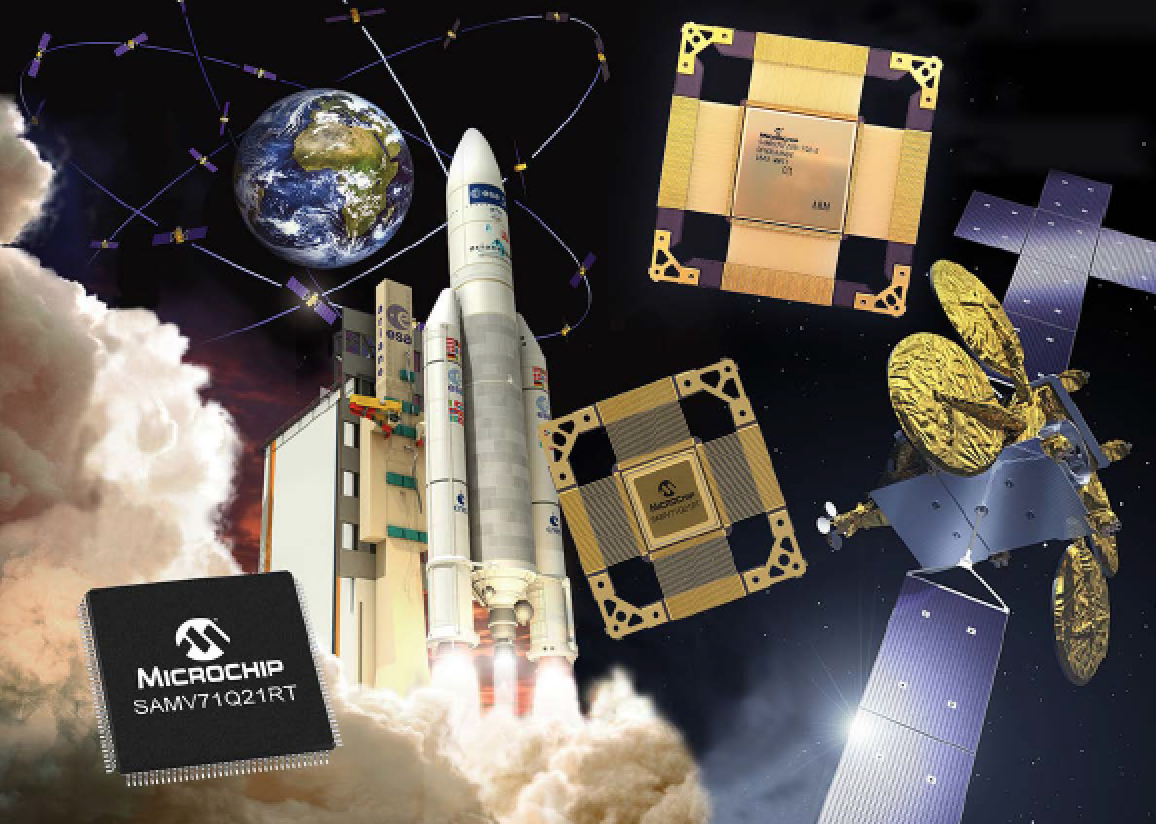The accelerating deployment of large constellations of Low Earth Orbit (LEO) smallsats is transforming how the space industry looks at its supply chain and component reliability requirements. These “New Space” deployments are driving rapid worldwide growth in space programs and associated investments in space systems and their downstream applications. This, in turn, has spurred similarly high growth in the volume of components that are needed to build them.

These components, however, will now have lifecycles of three to five years, rather than several decades, which requires new approaches for reducing cost without compromising reliability. The component qualification processes that supported space programs with decades-long launch timetables must now be aligned to the mission of putting up thousands of satellites over a few short years.
Evolving Reliability Demands
Ultra-high levels of component reliability have traditionally been essential to space mission success. Components used in missions to the Moon, Mars, or nearby asteroids had to survive extremely harsh conditions. Long-term reliability was also an issue, as components had to support a satellite in geostationary orbit for up to 20 years. These and other missions required that component development and testing be oriented to producing the highest levels of reliability in what typically were small volumes of devices with high unit costs.
Many of these components are radiation hardened by design (RHBD). They use high levels of redundancy with special libraries, ensuring that no elements are vulnerable to the single event upsets (SEU) caused by radiation. All susceptible elements are built on special, robust and reliable radiation-hardened (rad hard) silicon processes. Complex and rigorous Qualified Manufacturers List (QML) Process Flows confirm their reliability as defined by the Defense Logistics Agency (DLA). These processes span hundreds of tests across wide temperature ranges.
For the most challenging designs with long lifetimes in space, QML Process Flows also include detailed reporting and tracing, and ensure that devices are fully tested at both the wafer and package level as well as during final assembly. The benefits of this testing have been demonstrated with systems such as the Hubble Space Telescope and Mars rovers. Recent issues aside, Hubble has endured 30 years on-orbit and could even last another decade. Likewise, the Mars rovers have run successfully on the planet’s surface for years, even though they were only designed to last 15 days there.
These are very different mission profiles than those associated with New Space. With traditional space missions, it might cost $60 million to procure 1,000 parts a year that took considerable time to design, build, test, and deliver, and potentially were a decade old, or more, by the time the platform launched.
This is not acceptable for constellations such as those deployed by SpaceX, Amazon and OneWeb that span thousands of satellite launches over a few years. These platforms need today’s latest processors, interfaces, and data and communications protocols, and devices with the right packaging for the application, from ruggedized plastic to ceramic and hermetically sealed options.

New Space projects are also based on much different economic models than traditional missions. Ridesharing launches and reusable rockets have dramatically reduced the cost of launching satellites into orbit and enabled the proliferation of smallsats and other platforms from research labs and start-ups around the world. To carry out these missions, New Space project managers have —until now — been faced with two unsatisfactory options for component reliability qualification.
The traditional, highest level of reliability is generally overkill for LEO satellites, but the alternative of Commercial-Off-The-Shelf (COTS) options has also presented challenges related to these devices’ wider spread of performance. This can create problems for operating satellites, particularly when the temperature varies, and reduce lifetimes. Even smallsats can benefit from having the longest lifetime possible. Worse, these COTS parts can enter their end-of-life phase just when the satellites are ready for launch.
One way to mitigate this risk is to use automotive-qualified parts that have extended temperature ranges, but even these may not provide satisfactory reliability for LEO designs, or adequate availability for the mission. There are two other ways to support New Space missions with their requirements for lower cost and reduced development lead times.
Two Additional Options
An alternative approach for New Space program managers is to work with component suppliers that use a SubQML process flow with devices that capitalize on a space heritage derived from developing qualified designs that are RHBD. Packaged in ceramic or plastic, these devices reduce overall costs while limiting the re-design efforts that would otherwise be needed for qualified space systems. This first option is a top-down approach in terms of cost-cutting strategy.
The other option is a scalable approach to space qualification that suppliers can offer if they have a large enough industrial and automotive portfolio. Microchip uses the term COTS + to describe this process. The Plus means the added value that can be added on top of the original COTS device, which could be related to qualification flow, radiation performances and extended temperature range.
For example, a “COTS to Rad Tolerant” device is a version of the original COTS design that includes radiation improvements to provide full latchup immunity in space. The devices were not initially designed for this environment but are selected to achieve between 20 to 50 Krad radiation tolerance and then packaged either in ceramic (under a QML equivalent flow) or plastic (under a high reliability quality flow) that provides the optimal qualification level at limited cost with full traceability. For an easier transition from plastic to ceramic packaging, the two versions can be pin-compatible so that only one printed circuit board design is required. This second option could even be extended to target COTS to Rad Hard devices. Component suppliers can reuse advanced COTS architectures and proven designs to create Rad Hard solutions that reach >100 Krad radiation immunity with a low SEU error rate. With this COTS upgrade approach, both RT and RHBD devices become part of the same device ecosystem as the initial COTS device.
An example of the scalability benefits of a common ecosystem is Microchip’s SAMRH707 radiation-hardened microcontroller (MCU). It reuses the company’s SAMV71 Automotive and SAMV71RT Rad Tolerant microcontroller design and architecture.
This rad hard System on Chip (SoC) is immune to single event latchup (SEL) below a Linear Energy Transfer (LET) threshold up to 78Mev.cm2/mg at 125 degrees C, and resistant to a total ionizing dose (TID) of more than 100 Krad. It combines an ARM Cortex-M7 controller core for over 100 Dhrystone Million Instructions per Second (DMIPS) of performance with a floating-point unit and digital signal processor. Also included are a dual Controller Area Network Flexible Data- Rate (CAN FD) bus interface, Ethernet Time Sensitive Networking, 200Mbit/s SpaceWire interface and a MIL-STD-1553 bus, along with analog-to-digital converter (ADC) and analog front end.
This type of scalability offers the potential for a broad and growing spectrum of space-qualified components spanning diverse project requirements. It could be applicable to any type of components including FPGAs, power devices, memories, oscillators, and microcontrollers to provide the broadest range of options across many different qualification levels.
Designers should work with suppliers that can help them to fully understand what is required in a project and what qualification level to specify. Upgrading commercial devices to rad-tolerant or even rad-hard performance may deliver the appropriate level of reliability for a project with a more attractive cost, volume and availability, as long as designers also have access to all required companion devices, from power management and memory to Ethernet and SERDES connectivity solutions, motor controllers, MOSFETS (metal-oxide-semiconductor field-effect transistor), oscillators, RF transceivers and data converters. Each must be qualified to the correct levels for the given mission while also meeting availability and security requirements.
Selecting the correct component qualification strategy from a supplier with the requisite product expertise and portfolio breadth will enable New Space system developers to deliver thousands of satellites in a short period of time that will last many years.


Bob Vampola
It will also enable governments and traditional prime contractors to reduce their costs without compromising system reliability and security and give universities and start-ups more economical solutions for their projects. In each of these scenarios, designers can now leverage multiple qualification levels to navigate the complex trade-offs between component cost, availability, and life expectancy across many different applications.
www.microchip.com
Author Bob Vampola is the Associate Vice President, Aerospace & Defense, Microchip Technology

